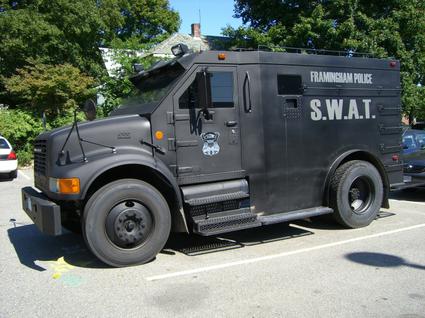SWAT shooting spurs debate
By Natalie Sherman | Friday, January 7, 2011 | http://www.bostonherald.com | Local Coverage
The fatal shooting of an innocent 68-year-old man by Framingham police reignited debate among law enforcement experts yesterday over the role of heavily armed, specialized units for routine drug busts.
“Dynamic entry — there’s a time and place for that, but in nine times of out of 10, it’s not a hostage-type situation,” said John Gnagey, executive director of National Tactical Officers Association, which trains SWAT teams around the country. “There are other things that you can do.”
Eurie Stamps was shot to death inside a home in Framingham on Tuesday after police arrested two 20-year-old unarmed men on drug charges. A Framingham SWAT team member yesterday was placed on administrative leave in connection with the shooting, the department said.
The National Tactical Officers Association advocates moving away from using “no-knock” tactics during low-level drug busts that are unlikely to evolve into complex tactical situations, Gnagey said.
In a statement about the shooting, Framingham police said the department will await the findings of an investigation by the Middlesex District Attorney’s Office before taking any additional administrative action.
The Stamps incident is hardly the first SWAT raid to have resulted in a death.
In May, a 7-year-old girl was shot when Detroit police stormed the wrong house looking for a murder suspect. In 2006, an 88-year-old Atlanta woman was killed after she fired shots at police busting into her home, an incident that prompted an investigation into the use of “no-knock” warrants. In Boston in 1994, a 75-year-old minister died from a heart attack 45 minutes after police mistakenly raided his home looking for drugs.
“SWAT teams were originally conceived to respond to an already violent situation,” said Radley Balko, author of “Overkill: The Rise of Paramilitary Raids in America” and a senior editor at libertarian Reason magazine. “The problem of using them to serve these warrants for nonviolent crimes is that you are creating violence where none existed before.”
First introduced in Los Angeles after the Watt Riots, the use of SWAT teams has risen dramatically since 1980, from 3,000 SWAT deployments per year to more than 50,000 now — the vast majority used during drug arrests, Balko said.
“We’re deploying an extraordinary level of resources to chase down and ferret out low-level crack cocaine dealers,” said Boston University professor of criminal justice Thomas Nolan, a former Boston police lieutenant. “I think it’s a fair question to ask law enforcement: Are the resources being devoted to these drug investigations worth the cost?”
Article URL: http://www.bostonherald.com/news/regional/view.bg?articleid=1307916







































0 comments:
Post a Comment